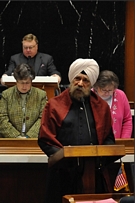Spiritual and visual treats from a thoughtful artist
by Andrea Neal
December 6, 2003
In the course of a productive and acclaimed career as artist and architect, K. P. Singh found one more calling: celebrating the human spirit.
All three of his gifts converge in “The Art and Spirit of K. P. Singh,” a 241-page journey across the globe filled with intricate pen-and-ink drawings for which Singh is known and short meditations on faith-filled themes — spiritual testimony which Singh humbly says at the outset “breaks no new ground.”
It is nonetheless fertile ground that will nourish your mind and soul.
If you don’t own a Singh original or print, you are surely familiar with his work because he specializes in landmarks that are familiar and beloved: churches and temples, courthouses, historic homes, monuments, schools, universities. What DePauw grad worth his diploma hasn’t put Singh’s “East College” print on his office wall?
That makes this book so much more than a timeless coffee table decoration. Hours can be spent leafing through more than 240 illustrations in search of a favorite architectural landmark (chances are you will find it), reading the “fine print” captions that accompany many of his drawings or enjoying the essays, poetry and prayer sprinkled throughout.
Readers may be less familiar with Singh’s life story, which began in 1939 in the town of Jaranwala in what is now Pakistan. Singh was not yet a teen when political and religious turbulence tore his world apart. His family’s survival convinced him of God’s compassion and imbued a sense of gratitude that pervades his art and his writings.
Singh tells of the “caravans of terrified displaced humanity” that followed the 1947 partition of British India into the independent states of India and Pakistan, and his family’s miraculous escape from death. As many as 2 million Hindus, Muslims and Sikhs were killed in violence that accompanied the forced transfer of peoples between the countries. Some 20,000 died in a massacre in Singh’s hometown.
Living temporarily in homes abandoned by Muslim families in India, Singh remembers his father consoling his grandfather: “Bajupee (Father), by God’s grace we have survived; we are alive; we will rebuild our lives again.”
“As I look back, I see continued affirmations and unexpected gifts along the journey of my life,” Singh writes.
In 1965, Singh came to the United States to pursue his education in architecture and city planning. After studying at the University of Michigan, he settled in Indianapolis in 1967.
Singh, whose religion is Sikh, calls on scriptural insight from many faith traditions and calls on fellow citizens to embrace the diversity around them.
All living things, threaded in one universal spirit.
Cherish hope, friendship and understanding.
Let us affirm tolerance of our unique individuality.
Honor all peaceful expressions of our humanity.
For Singh, architecture is one such expression. Although humans have damaged and destroyed buildings in wars and conflicts over centuries, historic structures that withstand the ravages of time are his inspiration. Among those featured in the book: Pampapati Temple, Hampi, India; St. Peter’s Cathedral, Rome; Sainte Chappelle, Paris; St. Mark’s Basilica, Venice, Italy; Chennakesava Temple, Belur, India; the Taj Mahal in Agra, India.
Closer to home, Indianapolis readers will be thrilled to see drawings of their own houses of worship. Among them: St. Joan of Arc, St. Mark’s, Holy Trinity and St. John’s Catholic churches; Christ Church Cathedral; St. Paul’s Episcopal; Second Presbyterian; Broadway United Methodist Church, to name just a few.
Missing from the book and missed by the reader is an index of illustrations, which would aid tremendously in the search for a specific one. Still, time spent hunting through the pages is generously rewarded. Like with a good movie, you will see something new, and be inspired anew, every time you open the cover.

















